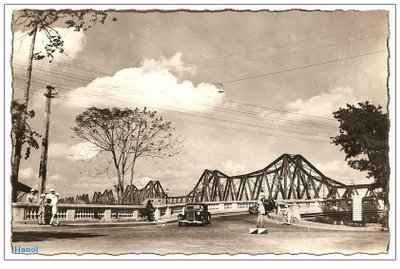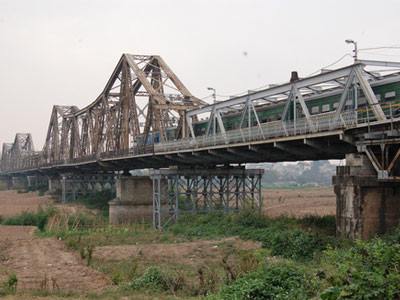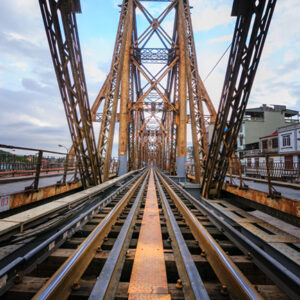Nestled in the heart of Hanoi, Long Bien Bridge stands as a testament to time, resilience, and architectural brilliance. While Hoan Kiem Lake symbolizes Hanoi’s elegance and charm, Long Bien Bridge reflects the courage and spirit of a capital forged through wartime struggles. Whether you’re a history buff, a photography enthusiast, or a traveler seeking authentic experiences, this iconic structure promises a unique journey through Hanoi’s past and present.
A Glimpse Into Long Bien Bridge’s Rich History
Long Bien Bridge is more than just a crossing but a living relic of Vietnam’s tumultuous past. Constructed between 1899 and 1902 during the French colonial period, the bridge was originally named Paul Doumer after the French Governor-General. However, the Vietnamese people have long referred to it as Long Bien or Cai River Bridge.
This architectural marvel was designed by French engineers but brought to life by Vietnamese hands. Local workers used indigenous materials—wood from Phu Tho, Yen Bai, and Thanh Hoa provinces, cement from Hai Phong, and Long Tho lime from Hue—to craft this enduring structure. Spanning the Red River with 19 steel spans, Long Bien Bridge was the first of its kind in Hanoi and one of the four greatest bridges in the world at the time of completion.

Long Bien Bridge in 1950.
A Symbol of Resilience and Victory
In its early years, Long Bien Bridge was hailed as a masterpiece of engineering and a symbol of architectural prowess in the Far East. Beyond its aesthetic appeal, it played a pivotal role in Vietnam’s history. During the First Indochina War, the bridge served as a vital lifeline, transporting tons of rice from northern Vietnam to the Dien Bien Phu battlefield. This logistical support was instrumental in Vietnam’s victory over French forces in 1954, cementing Long Bien’s status as a symbol of courage and national pride.
However, the bridge’s story is also one of survival. Over its 120+ years of existence, Long Bien endured significant damage from decades of conflict. During the Vietnam War, it was repeatedly bombed by American air forces in 1967 and 1972, leaving several of its spans destroyed. Today, the remaining sections stand as poignant reminders of an unforgettable past, blending historical significance with architectural beauty.
Long Bien Bridge Stands Out Today
Today, Long Bien Bridge remains one of Hanoi’s most cherished landmarks. It’s no longer the only bridge spanning the Red River—there are now five in total—but it holds a unique place in the city’s landscape. Unlike its modern counterparts, Long Bien is steeped in history, culture, and charm, offering visitors an experience that goes beyond mere transportation.
Unique Features of Long Bien Bridge
- Left-Hand Traffic Tradition: Long Bien is the only bridge in Hanoi where all riders must travel on the left-hand side.
- A Pedestrian Paradise: Tourists and locals alike can stroll across the bridge, soaking in stunning views of the Red River and the city skyline.
- A Hub of Local Life: From vendors selling mouthwatering street food to an open-air market where Hanoians buy fresh vegetables and fish, the bridge buzzes with daily activity.
- Photography Haven: Whether it’s the golden hues of sunrise, the fiery glow of sunset, or the lush greenery of the alluvial patches below, Long Bien is a favorite spot for capturing unforgettable moments.
For wedding photographers, young couples, and teenagers, the bridge serves as a timeless backdrop for creating memories. Its weathered steel beams and rustic charm add character to every photo, while the surrounding scenery offers a blend of natural beauty and urban grit.
Top Things to Do at Long Bien Bridge
A visit to Long Bien Bridge is more than just a sightseeing stop—it’s an immersive experience that connects you to Hanoi’s soul. Here are some must-do activities to make the most of your trip:
- Catch the Sunrise or Sunset: Many locals and travelers agree that Long Bien offers the best vantage point in Hanoi for watching the day begin or end. Bring your camera to capture the stunning interplay of light and water.
- Savor Street Food: Stop by the vendors lining the bridge for a taste of Hanoi’s culinary delights. Don’t miss our guide to the “5 Street Vendors You Should Not Miss in Hanoi” for insider tips!
- Explore the Afternoon Market: Join Hanoians as they shop for fresh produce and seafood in the bridge’s open-air market—a perfect way to experience local culture.
- Take a Scenic Walk: Stroll across the bridge to enjoy panoramic views of the Red River and the alluvial patches below, dotted with greenery.
- Watch the Trains: Trains still rumble across Long Bien daily, adding a touch of nostalgia to this historic structure.
For history enthusiasts, the bridge’s weathered spans and wartime scars offer a tangible link to Vietnam’s past. Meanwhile, the vibrant energy of vendors, cyclists, and pedestrians keeps it firmly rooted in the present.

Long Bien Bridge.
How to Get to Long Bien Bridge
Reaching Long Bien Bridge is a breeze, making it an easy addition to your Hanoi travel plans. Here are your options:
- By Motorbike: Rent a motorbike and ride to the bridge—just remember to stick to the left-hand side! This is a popular choice for adventurous travelers looking to explore Hanoi like a local.
- On Foot: If you’re staying in the Old Quarter, the bridge is just over 1 kilometer away—a pleasant 15-20 minute walk through Hanoi’s bustling streets.
Once you arrive, take your time to soak in the sights, sounds, and stories that make Long Bien so special.
The Future of Long Bien Bridge
Long Bien Bridge’s future looks promising. In 2024, France provided Hanoi over 700,000 euros to renovate the capital’s historic landmark. French experts are surveying and studying the current status of Long Bien Bridge to propose solutions for its repair and future use. Approved by Hanoi’s authorities, the study—set to conclude by late 2025—will propose repairs and future uses, potentially transforming it into a pedestrian zone or museum while preserving its heritage. Exciting changes are on the horizon for this iconic structure!
Visit Long Bien Bridge in Hanoi
Long Bien Bridge is more than a Hanoi attraction. It’s a living piece of history that continues to shape the city’s identity. Its architectural grandeur, its wartime resilience, or its role in daily Hanoian life promises a blend of reflection and discovery. Walk its length, taste its street food, and capture its beauty, all while honoring the memories it holds.
If Hanoi is on your travel radar, don’t miss the chance to experience Long Bien Bridge firsthand. From the tranquility of its river views to the vibrancy of its markets, this iconic structure offers a window into the heart of Vietnam’s capital.














